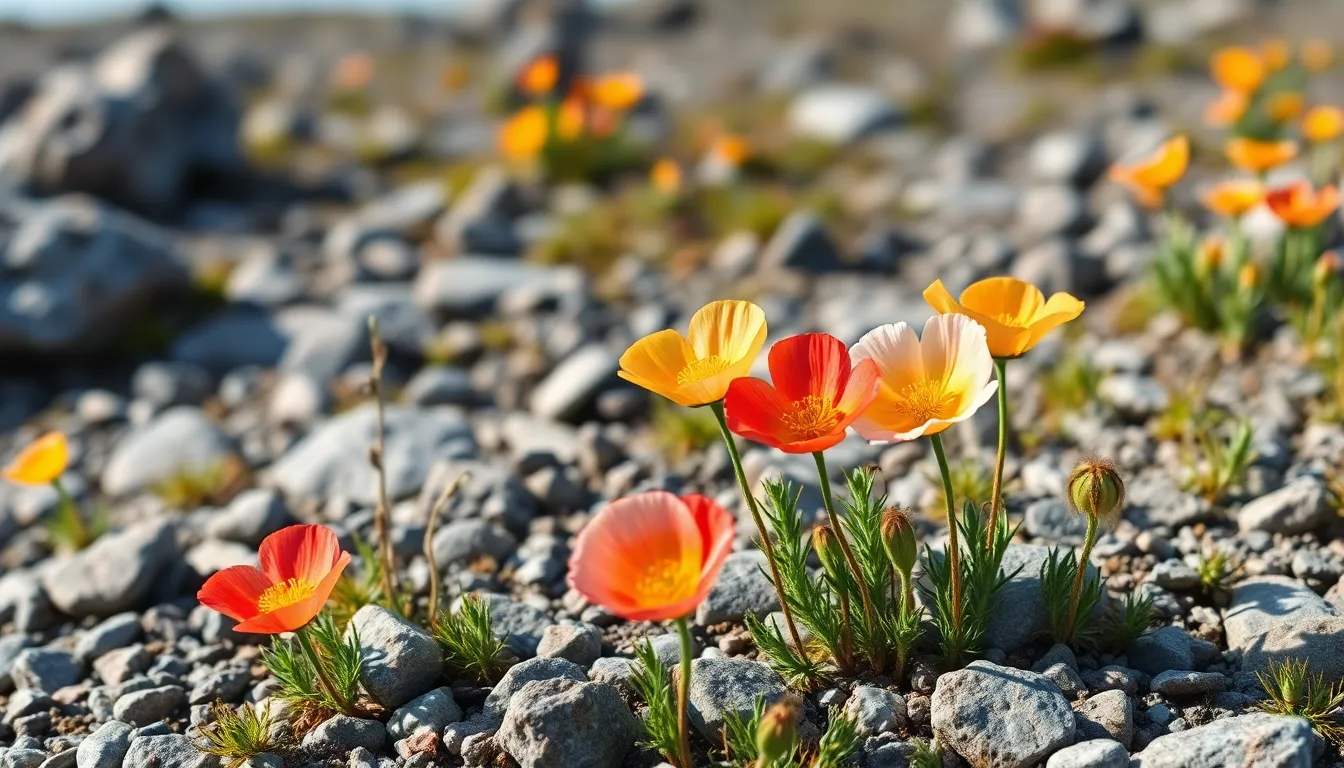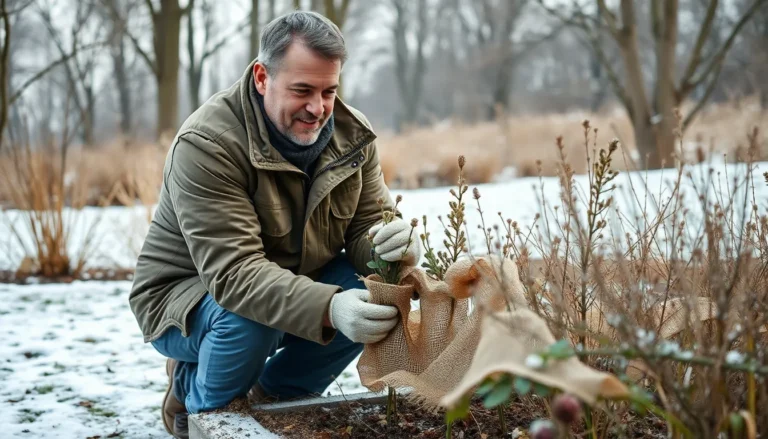
What Plants Are in the Arctic? Discover the Surprising Flora Thriving in Extreme Conditions
When one thinks of the Arctic, images of icy landscapes and polar bears often come to mind. But what about the brave little plants that manage to thrive in such a frosty realm? Surprisingly, the Arctic is home to a variety of resilient flora that’s adapted to the extreme conditions. These plants may not be the life of the party, but they sure know how to survive the cold!
What Plants Are in the Arctic
Arctic flora consists of a variety of hardy plants that adapt to extreme cold and short growing seasons. Many species thrive in this challenging environment, exhibiting resilience and unique survival strategies.
Low-growing plants dominate the region, including lichens, mosses, and sedges. Lichens, for instance, form symbiotic relationships between fungi and algae, enabling them to withstand harsh conditions. Mosses contribute significantly to soil formation and moisture retention, promoting a microhabitat for other organisms.
Perennial plants, such as Arctic poppies and saxifrages, emerge early in the spring, taking advantage of fleeting sunlight. These perennials excel in nutrient-poor soils, often blooming quickly before the snow fully melts.
Shrubs also play a vital role in Arctic ecosystems. Dwarf willow and birch species withstand cold temperatures, providing critical habitat for various animals. These shrubs’ ability to grow close to the ground minimizes exposure to wind and frost.
Additionally, wildflowers, like the Arctic bellflower and mountain avens, showcase vibrant colors amidst the icy backdrop. Their ability to store energy and nutrients allows them to survive through intermittent growing seasons.
Adaptations among these plants enhance their chances of survival. Thick cuticles reduce water loss, while deep roots anchor them against strong winds. The complex relationships among Arctic flora contribute extensively to the region’s biodiversity and ecosystem stability.
Types of Plants Found in the Arctic

Arctic ecosystems contain diverse plant life that showcases remarkable adaptability. Plant species fall into two primary categories: vascular and non-vascular.
Vascular Plants
Vascular plants thrive despite the challenging Arctic climate. Examples include Arctic poppies, which bloom early to utilize abundant spring sunlight. Dwarf willow and birch serve critical ecological roles by providing shelter for various wildlife. These plants feature adaptations like small leaves and shallow root systems, enabling them to survive with limited nutrients. Saxifrages display resilience by growing in rocky crevices where few other plants can establish. Low-growing tundra vegetation captures sunlight efficiently, maximizing growth within short seasons.
Non-Vascular Plants
Non-vascular plants, particularly lichens and mosses, dominate the Arctic landscape. Lichens exhibit unique symbiotic relationships between fungi and algae, allowing survival in nutrient-poor environments. They grow on rocks and soil, helping to establish and stabilize ecosystems. Mosses excel in moisture retention, thus contributing to soil formation. These plants often carpet the ground, forming crucial habitats for small organisms. Their ability to endure extreme conditions highlights the importance of non-vascular species in maintaining ecological balance.
Adaptations of Arctic Plants
Arctic plants exhibit remarkable adaptations that enable them to survive in extreme conditions. These adaptations ensure their resilience against cold, limited sunlight, and scarce water resources.
Cold Resistance
Cold resistance is essential for Arctic flora. Many plants possess thick cuticles that minimize moisture loss while insulating them against frigid temperatures. Some also adopt a low growth form that helps them avoid harsh winds and frost. For instance, Arctic poppies and saxifrages bloom early in spring, effectively utilizing brief periods of sunlight for growth. Other species, such as dwarf willow and birch, have small leaves, which reduce water loss and protect them from freezing. This combination of thick structures and unique growth strategies allows them to thrive even in harsh environments.
Water Conservation
Water conservation plays a crucial role in the survival of Arctic plants. They often develop shallow roots to absorb moisture from melting snow and soggy ground. Mosses, a dominant plant group in the Arctic, excel in retaining water, creating a microhabitat that benefits nearby species. Drought-resistant traits further enhance their survival, as many plants can store water in their tissues for later use. Lichens form symbiotic relationships that promote moisture absorption and stabilize soil, ensuring better sustainability in this challenging landscape. Through these strategies, Arctic flora effectively navigates their water-scarce environment.
Importance of Arctic Plants
Arctic plants play a crucial role in maintaining ecological balance. These hardy species contribute significantly to the overall health of their ecosystems.
Ecosystem Contributions
Plants in the Arctic contribute to soil formation and nutrient cycling. Mosses and lichens help retain moisture, creating habitats for small organisms. By stabilizing the soil, they prevent erosion, especially in fragile landscapes. Vascular plants like Arctic poppies and dwarf willow provide food and shelter for wildlife. Through photosynthesis, these plants generate oxygen, essential for the region’s biodiversity. This process supports not only plant life but various herbivorous animals that rely on them for sustenance.
Cultural Significance
Arctic plants hold considerable cultural value for indigenous communities. Many species serve as traditional food sources, offering nutritional sustenance through harsh winters. Medicinal plants like Arctic willow play a role in local health practices, offering remedies for various ailments. Furthermore, these plants contribute to local crafts and artistic expressions, showcasing the deep connection between culture and nature. Celebrating the flora fosters a sense of identity and belonging among indigenous people, emphasizing their stewardship of the land.
Conservation Challenges
Conservation challenges threaten the resilience of Arctic plants amid climate change and human impacts. Rapid warming in the Arctic alters habitats crucial for plant survival. Increased temperatures lead to shifting growing seasons, affecting flowering times and pollination processes.
Pollution poses significant risks as well, introducing toxic substances that harm plant health. Airborne pollutants can deposit on the fragile Arctic ecosystems, disrupting growth patterns in sensitive species like Arctic poppies and saxifrages. Additionally, invasive species can outcompete native flora, threatening biodiversity and habitat stability.
Habitat loss is directly tied to ecological changes, making it crucial to monitor plant populations closely. Deforestation and development surrounding Arctic regions reduce available land for native species to thrive. Wetlands, important for mosses and lichens, face drainage and degradation, which exacerbates water scarcity related to drought conditions.
Research shows that the loss of plant biodiversity also impacts local wildlife. Herbivores rely on healthy plant communities for food sources, and a decline in nutrient-rich plants can reduce their populations. This cycle ultimately endangers species that depend on herbivores for survival.
Conservation efforts are underway to address these challenges. Restoration projects aim to bring invasive species under control and bolster native plant populations. Collaboration between local communities and conservation organizations fosters sustainability and knowledge sharing.
Adopting best practices in land management ensures that future generations will enjoy and benefit from Arctic plant life. The need for awareness of these conservation challenges remains critical, as the fate of Arctic plants directly ties to the resilience of entire ecosystems.
Conclusion
The Arctic’s plant life showcases an incredible resilience that often goes unnoticed. These hardy species not only survive but thrive in one of the planet’s most extreme environments. With their unique adaptations and vital ecological roles, Arctic plants are crucial for maintaining the balance of their ecosystems.
As climate change and human activities pose increasing threats, the importance of conservation cannot be overstated. Protecting these plants is essential not just for their survival but for the health of the entire Arctic ecosystem. Understanding and appreciating the tenacity of Arctic flora fosters a deeper connection to this unique region and highlights the need for continued efforts in conservation and sustainability.



